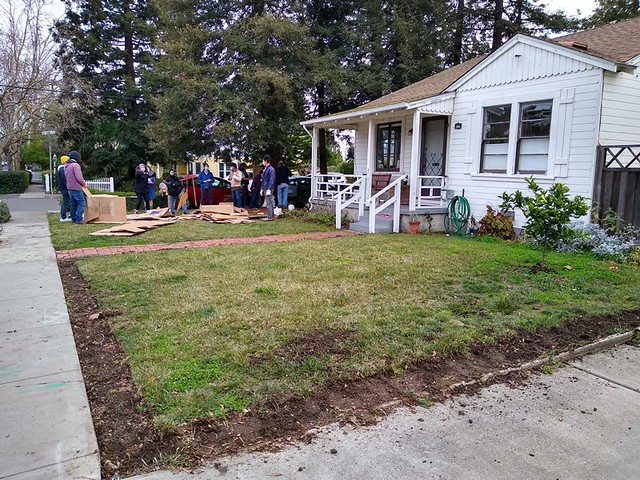Permaculture Design Course Graduates 12 in Benicia
By Allison Nagel, Program Manager

The 2021 Benicia PDC class participants, instructors and homeowners
Solano County’s first Permaculture Design Certificate course wrapped up on April 10, with 12 students presenting their capstone design projects and receiving their PDC certificates.
It was powerful to see how this group used what they had learned to shape plans for four very different projects: One on a gradual rewilding of an aging DMV site to create a city park space; one envisioning the transformation of bare soil and turf at a city park into a welcoming space for enjoyment and reflection; one creating a healing garden space at a veterans home; and one bringing regenerative farming practices to a homestead that could support the family that lives there and supply food for their restaurants.
It was also powerful to connect with a group of individuals that signed up for the PDC program for a variety of reasons, from professional advancement to personal goals, but who all brought their passion, knowledge and desire to shape a better world to the course and their projects.
The program was offered in Benicia through a partnership between Sustainable Solano and Benicia Adult Education. The PDC, which is an internationally recognized certification program, has 72 hours of standard required curriculum, but instructors bring their own expertise and insight to each program. We were lucky to have Lydia Neilsen and Anne Freiwald of Vital Cycles lead the PDC class in Benicia, which had a hands-on component focused on putting permaculture principles to use in a suburban setting.
The PDC demonstration project sheet-mulched the grass on the front yard of a Benicia home, dug an in-ground swale to capture rainwater from the roof of the house, planted guilds of plants that work together and support one another for a healthy ecosystem in the front yard, and installed a laundry-to-landscape greywater system that will take the used wash water and run it into mulch basins on the side yard for the plants there.
Video courtesy of PDC participant Sylvia Herrera
I had the unique opportunity to pursue my PDC along with the class, allowing me to reach a life goal I set back when I first started volunteering with Sustainable Solano and learning about permaculture. The program wasn’t without challenges. COVID-19 caused huge shifts in when we could offer the course, and then we had to make logistical adjustments to be able to offer the course safely under the state’s higher education guidelines. We were so fortunate that Anne and Lydia looked for creative ways to offer the class in a combination of online and in-person instruction; and that homeowners Chris and Megan, our newest Food Forest Keepers, generously made their backyard available for class instruction while the front and side yard were being transformed through the class’ hands-on projects. I appreciate the patience of my fellow students who pursued taking the course despite these challenges and worked to get the very most out of it. Along with the education that came from the program, I also feel we created a community among the class that comes from working so closely together.
The PDC course was offered as a part of our Workforce Development program, which has been a part of transforming three Benicia yards into food forest gardens that are edible, waterwise alternatives to lawns, while educating landscaping professionals, life-long learners and high school youth on permaculture principles and sustainable landscaping practices.
We are already starting to plan for our next PDC course! Interested? You can find details here in the coming months. And feel free to email me at allison@sustainablesolano.org to be added to the interest list.
Congratulations to our 2021 Permaculture Design Certificate recipients!
John Davenport*
Scott Dodson*
Jonathan Erwin
Clay Ford
Karen Lee Ford
Sylvia Herrera
Ron Kane
Jason Lingnau
Allison Nagel
Katie Rivera
Jaxon Shain
Susan Worden
*Learn more about these participants on our Sustainable Landscaping Professionals page
The Benicia PDC program and demonstration project were funded through student fees, Benicia Adult Education, the second amendment to the Valero/Good Neighbor Steering Committee Settlement Agreement, and the Solano County Water Agency.







